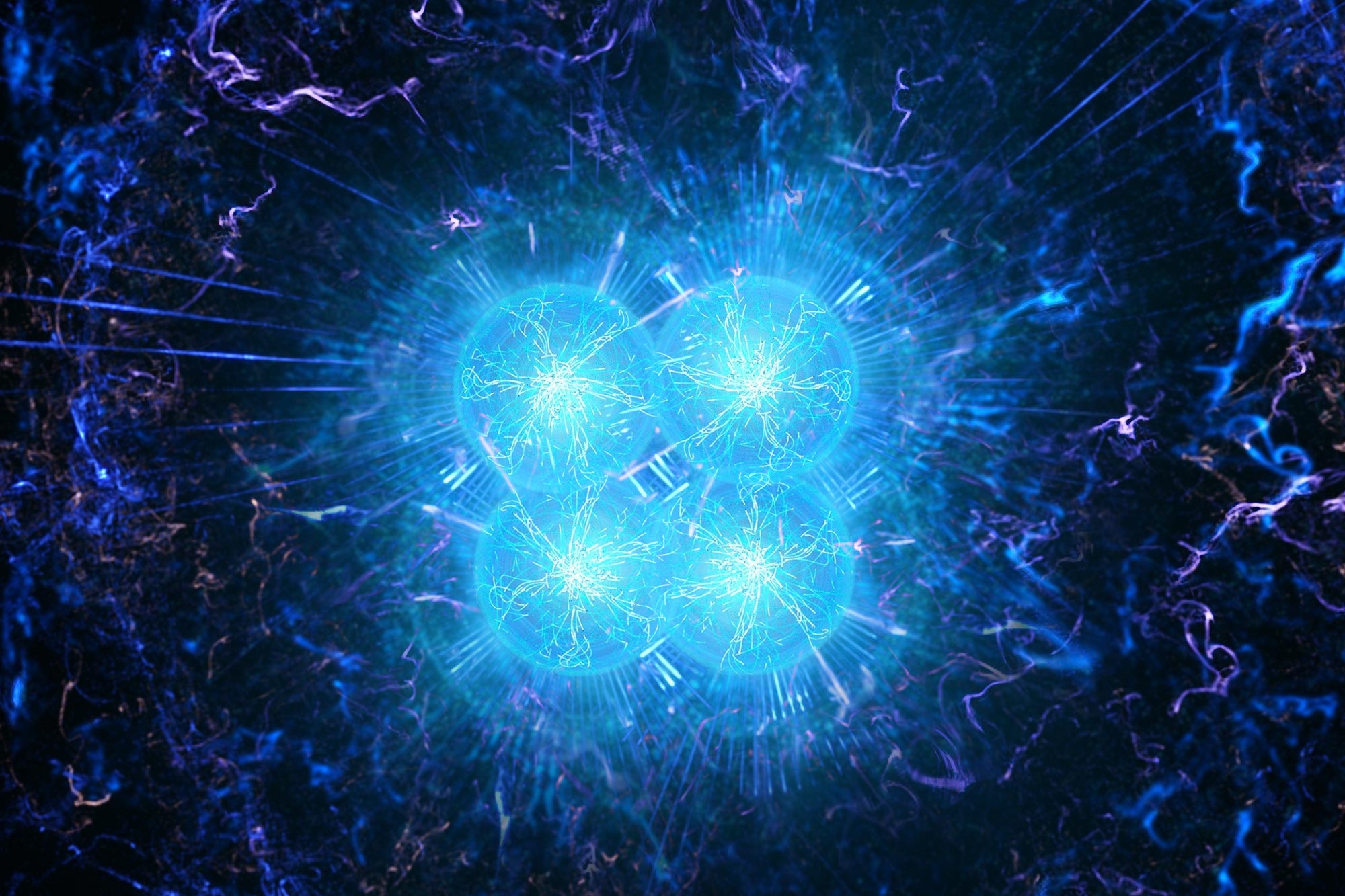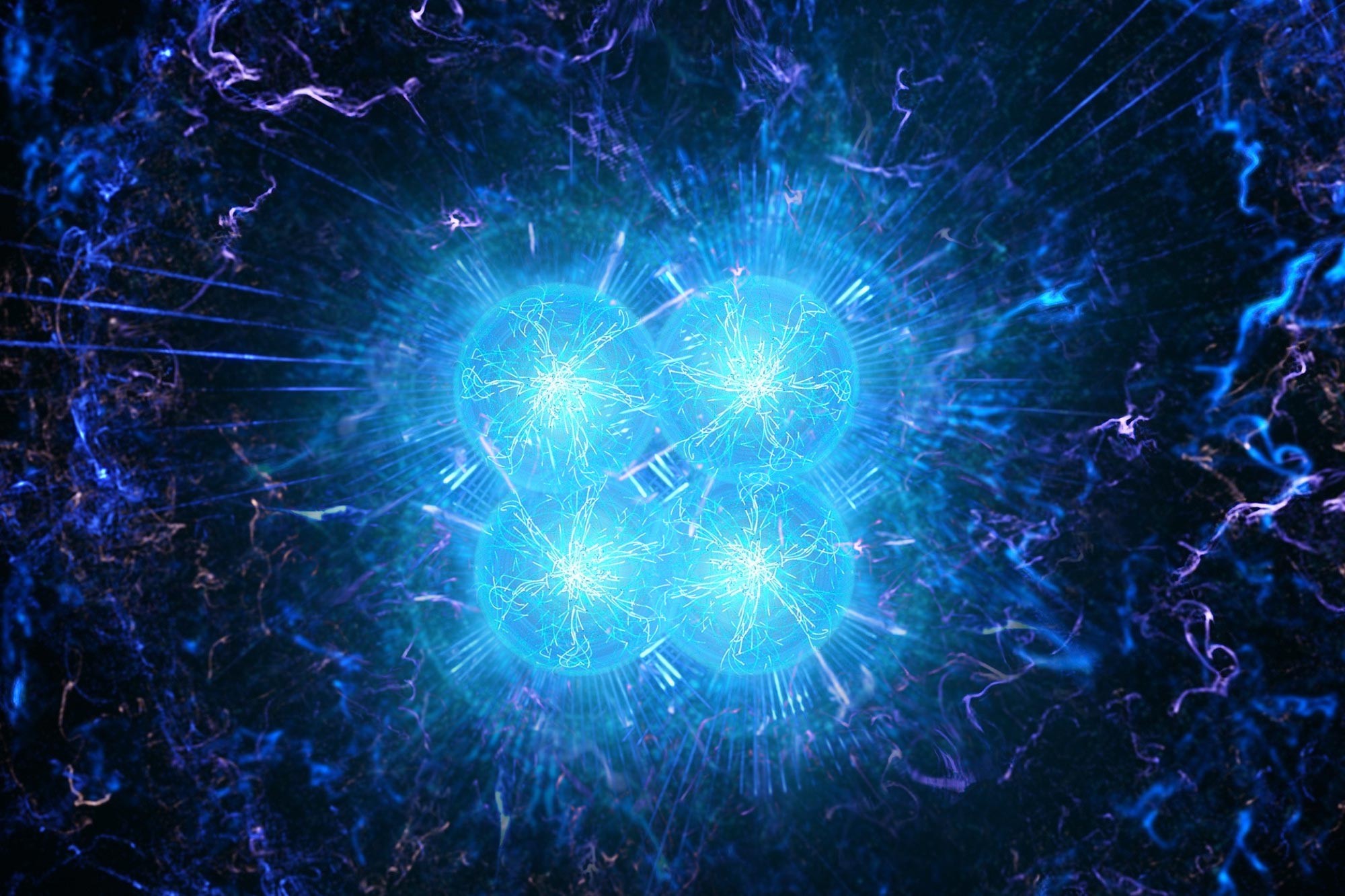
Vedci oznámili experimentálny objav tetraneutrónu, nového a exotického stavu hmoty, ktorý môže mať aj vlastnosti užitočné v existujúcich alebo vznikajúcich technológiách.
Teoretický fyzik James Vary čaká na experimenty jadrovej fyziky, ktoré potvrdia realitu „tetraneutrónu“, ktorý on a jeho kolegovia teoretizovali, predpovedali a prvýkrát oznámili počas prezentácie v lete 2014. Po výskumnej práci na jeseň 2016.
„Kedykoľvek prezentujeme teóriu, vždy musíme povedať, že čakáme na experimentálne potvrdenie,“ povedal Varys, profesor fyziky a astronómie na Iowskej štátnej univerzite.
V prípade štyroch neutrónov (veľmi, veľmi) spojených v dočasnom kvantovom stave alebo rezonancii, je teraz ten deň tu pre Varysa a medzinárodný tím fyzikov.
Nedávno ohlásený experimentálny objav tetraneutrónu medzinárodnou skupinou vedenou vedcami z nemeckej Technickej univerzity v Darmstadte otvára dvere novému výskumu a môže viesť k lepšiemu pochopeniu toho, ako je vesmír držaný pohromade. Tento nový a exotický stav hmoty môže mať tiež vlastnosti, ktoré sú užitočné v existujúcich alebo vznikajúcich technológiách.

Andrey Shirokov, vľavo z Moskovskej štátnej univerzity v Rusku, ktorý bol hosťujúcim vedcom v štáte Iowa, a James Vary z štátu Iowa sú súčasťou medzinárodného tímu jadrových fyzikov, ktorý teoretizoval, predpovedal a oznámil štruktúru štyroch neutrónov v roku 2014. . a 2016. Poďakovanie: Christopher Gannon / Iowa State’s College of Liberal Arts and Sciences
Po prvé, čo tak definícia?
Neutróny, ktoré si pravdepodobne pamätáte z hodiny vedy, sú subatomárne častice bez náboja, ktoré sa spájajú s kladne nabitými protónmi a vytvárajú jadro[{“ attribute=““>atom. Well, individual neutrons aren’t stable and after a few minutes convert into protons. Combinations of double and triple neutrons also don’t form what physicists call a resonance, a state of matter that is temporarily stable before it decays.
Enter the tetraneutron
Using the supercomputing power at the Lawrence Berkeley National Laboratory in California, the theorists calculated that four neutrons could form a resonant state with a lifetime of just 3×10^(-22) seconds, less than a billionth of a billionth of a second. It’s hard to believe, but that’s long enough for physicists to study.

This graph shows experimental measurements and theoretical predictions for the tetraneutron’s energy and width, essential properties of this exotic state of matter. The measurements are in millions of electron volts, a common unit of measurement in high-energy and nuclear physics. The most recent experimental results are second from the left and labelled 2022. The theoretical predictions by the research group that includes Iowa State’s James Vary are the four columns labelled “NCSM” and represent results from different realistic inter-neutron interactions. These results were published in 2016 and 2018. The theoretical predictions labelled “GSM” were published in 2019 by a group based in China. They use a different method that complements the NCSM method. Publication details are also listed. Credit: James Vary/Iowa State University
A detail or two
The theorists’ calculations say the tetraneutron should have an energy of about 0.8 million electron volts (a unit of measurement common in high-energy and nuclear physics – visible light has energies of about 2 to 3 electron volts.) The calculations also said the width of the plotted energy spike showing a tetraneutron would be about 1.4 million electron volts. The theorists published subsequent studies that indicated the energy would likely lie between 0.7 and 1.0 million electron volts while the width would be between 1.1 and 1.7 million electron volts. This sensitivity arose from adopting different available candidates for the interaction between the neutrons.
A just-published paper in the journal Nature reports that experiments at the Radioactive Isotope Beam Factory at the RIKEN research institute in Wako, Japan, found tetraneutron energy and width to be around 2.4 and 1.8 million electron volts respectively. These are both larger than the theory results but Vary said uncertainties in the current theoretical and experimental results could cover these differences.
Why it’s a big deal
“A tetraneutron has such a short life it’s a pretty big shock to the nuclear physics world that its properties can be measured before it breaks up,” Vary said. “It’s a very exotic system.”
It is, in fact, “a whole new state of matter,” he said. “It’s short-lived, but points to possibilities. What happens if you put two or three of these together? Could you get more stability?”
Experiments trying to find a tetraneutron started in 2002 when the structure was proposed in certain reactions involving one of the elements, a metal called beryllium. A team at RIKEN found hints of a tetraneutron in experimental results published in 2016.
“The tetraneutron will join the neutron as only the second chargeless element of the nuclear chart,” Vary wrote in a project summary. That “provides a valuable new platform for theories of the strong interactions between neutrons.”
The papers, please
Meytal Duer of the Institute for Nuclear Physics at the Technical University of Darmstadt is the corresponding author of the Nature paper — “Observation of a correlated free four-neutron system” — announcing the experimental confirmation of a tetraneutron. The experiment’s results are considered a five-sigma statistical signal, denoting a definitive discovery with a one in 3.5 million chance the finding is a statistical anomaly.
The theoretical prediction was published October 28, 2016, in the journal Physical Review Letters (Prediction for a Four-Neutron Resonance). Andrey Shirokov of the Skobeltsyn Institute of Nuclear Physics at Moscow State University in Russia, who has been a visiting scientist at Iowa State, is the first author. Vary is one of the corresponding authors. Grants from the U.S. Department of Energy, the National Energy Research Scientific Computing Center, the Germany and U.S. Nuclear Theory Exchange Program and the Russian Science Foundation supported the theoretical work.
Written with a smile
“Can we create a small neutron star on Earth?” Vary titled a summary of the tetraneutron project. A neutron star is what’s left when a massive star runs out of fuel and collapses into a super-dense neutron structure. The tetraneutron is also a neutron structure, one Vary quips is a “short-lived, very-light neutron star.”
A personal reaction
“I had pretty much given up on the experiments,” Vary said. “I had heard nothing about this during the pandemic. This came as a big shock. Oh my God, here we are, we may actually have something new.”
Reference: “Observation of a correlated free four-neutron system” by M. Duer, T. Aumann, R. Gernhäuser, V. Panin, S. Paschalis, D. M. Rossi, N. L. Achouri, D. Ahn, H. Baba, C. A. Bertulani, M. Böhmer, K. Boretzky, C. Caesar, N. Chiga, A. Corsi, D. Cortina-Gil, C. A. Douma, F. Dufter, Z. Elekes, J. Feng, B. Fernández-Domínguez, U. Forsberg, N. Fukuda, I. Gasparic, Z. Ge, J. M. Gheller, J. Gibelin, A. Gillibert, K. I. Hahn, Z. Halász, M. N. Harakeh, A. Hirayama, M. Holl, N. Inabe, T. Isobe, J. Kahlbow, N. Kalantar-Nayestanaki, D. Kim, S. Kim, T. Kobayashi, Y. Kondo, D. Körper, P. Koseoglou, Y. Kubota, I. Kuti, P. J. Li, C. Lehr, S. Lindberg, Y. Liu, F. M. Marqués, S. Masuoka, M. Matsumoto, J. Mayer, K. Miki, B. Monteagudo, T. Nakamura, T. Nilsson, A. Obertelli, N. A. Orr, H. Otsu, S. Y. Park, M. Parlog, P. M. Potlog, S. Reichert, A. Revel, A. T. Saito, M. Sasano, H. Scheit, F. Schindler, S. Shimoura, H. Simon, L. Stuhl, H. Suzuki, D. Symochko, H. Takeda, J. Tanaka, Y. Togano, T. Tomai, H. T. Törnqvist, J. Tscheuschner, T. Uesaka, V. Wagner, H. Yamada, B. Yang, L. Yang, Z. H. Yang, M. Yasuda, K. Yoneda, L. Zanetti, J. Zenihiro and M. V. Zhukov, 22 June 2022, Nature.
DOI: 10.1038/s41586-022-04827-6
The theorists
In addition to Vary and Shirokov, others involved in the theoretical prediction of a tetraneutron were George Papadimitriou of Lawrence Livermore National Laboratory in California (and a former postdoctoral research associate at Iowa State); Alexander Mazur of Pacific National University in Khabarovsk, Russia; Igor Mazur, also of Pacific National University; and Robert Roth of Technical University of Darmstadt in Germany.

Web nerd. Extreme organizer. Writer. Whole foods evangelist. Certified introvert.

